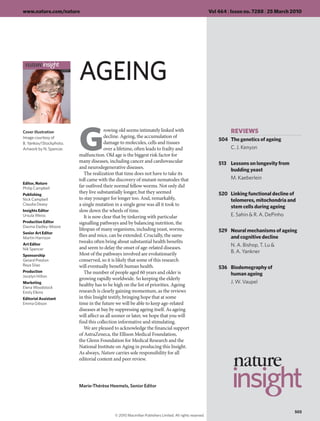Nature ageing 2010
- 1. Cover illustration Image courtesy of B. Yankov/iStockphoto. Artwork by N. Spencer. REVIEWS 504 The genetics of ageing C. J. Kenyon 513 Lessons on longevity from budding yeast M. Kaeberlein 520 Linking functional decline of telomeres, mitochondria and stem cells during ageing E. Sahin & R. A. DePinho 529 Neural mechanisms of ageing and cognitive decline N. A. Bishop, T. Lu & B. A. Yankner 536 Biodemography of human ageing J. W. Vaupel G rowing old seems intimately linked with decline. Ageing, the accumulation of damage to molecules, cells and tissues over a lifetime, often leads to frailty and malfunction. Old age is the biggest risk factor for many diseases, including cancer and cardiovascular and neurodegenerative diseases. The realization that time does not have to take its toll came with the discovery of mutant nematodes that far outlived their normal fellow worms. Not only did they live substantially longer, but they seemed to stay younger for longer too. And, remarkably, a single mutation in a single gene was all it took to slow down the wheels of time. It is now clear that by tinkering with particular signalling pathways and by balancing nutrition, the lifespan of many organisms, including yeast, worms, flies and mice, can be extended. Crucially, the same tweaks often bring about substantial health benefits and seem to delay the onset of age-related diseases. Most of the pathways involved are evolutionarily conserved, so it is likely that some of this research will eventually benefit human health. The number of people aged 60 years and older is growing rapidly worldwide. So keeping the elderly healthy has to be high on the list of priorities. Ageing research is clearly gaining momentum, as the reviews in this Insight testify, bringing hope that at some time in the future we will be able to keep age-related diseases at bay by suppressing ageing itself. As ageing will affect us all sooner or later, we hope that you will find this collection informative and stimulating. We are pleased to acknowledge the financial support of AstraZeneca, the Ellison Medical Foundation, the Glenn Foundation for Medical Research and the National Institute on Aging in producing this Insight. As always, Nature carries sole responsibility for all editorial content and peer review. Marie-Thérèse Heemels, Senior Editor Editor, Nature Philip Campbell Publishing Nick Campbell Claudia Deasy Insights Editor Ursula Weiss Production Editor Davina Dadley-Moore Senior Art Editor Martin Harrison Art Editor Nik Spencer Sponsorship Gerard Preston Reya Silao Production Jocelyn Hilton Marketing Elena Woodstock Emily Elkins Editorial Assistant Emma Gibson AGEING 503 www.nature.com/nature Vol 464 | Issue no. 7288 | 25 March 2010 © 20 Macmillan Publishers Limited. All rights reserved10

